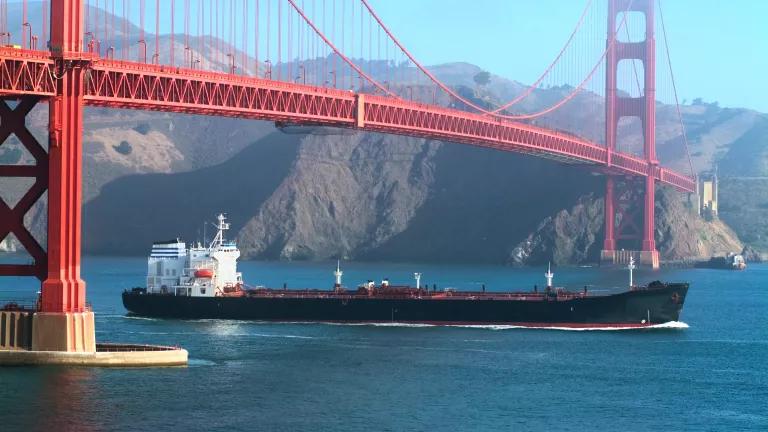
President Obama rejected TransCanada’s reckless pipeline project last year. Now we must tell him to block the Canadian company’s plan to ship that same dirty tar sands oil down our rivers and coasts.
For years, Americans across the country stood up against the Keystone XL dirty tar sands pipeline, writing letters to President Obama, marching on the White House, and speaking out from their homes to ask him to block this reckless and destructive project.
Last fall, the president did just that, rejecting the pipeline to protect our midwestern communities, waterways, ranches, and farms; defend the breadbasket of America; and strike a blow against the growing dangers of climate change.
Now TransCanada, the same company that tried to ram the Keystone XL down our throats, is trying an end run around the American people. It wants to send the same dirty tar sand crude across Canada to be loaded onto tankers, then shipped along our East Coast, around the tip of Florida and across the Gulf of Mexico to refineries along our southern coast.
That would put more than half of our ocean waters and coastline at risk of a tanker disaster, exposing our Atlantic and Gulf waters, the Eastern Seaboard, the Florida Keys, and our entire Gulf Coast to a catastrophic spill of tar sands crude — some of the dirtiest oil on the planet.
Nothing doing.
America’s heartland is not up for grabs. Neither are our ocean waters, marine life, coastal communities, and all they support. And neither is the future of our climate — and there’s where the problem with tar sands crude begins.
From the time it’s strip-mined or steamed out of the ground until it’s been refined and burned as fuel, tar sands crude generates 17 percent more of the dangerous carbon pollution that’s driving climate change than even conventional crude oil, the U.S. State Department calculates (p. ES-15). That’s just what we don’t need. It’s the wrong direction for our future. And it’s the exact opposite of what the United States, Canada, and more than 180 other nations agreed to last December in Paris, when we vowed to cut the dangerous fossil fuel pollution that is driving global climate change and shift to cleaner, smarter ways to power our future.
Dirty tar sands crude has no place in that future. Protecting our children against the growing dangers of climate change is reason enough to put an end to tar sands production. It’s hurting us, though, in other ways, too.
Tar sands crude is about as thick as asphalt. To transport it, the crude is mixed with solvents similar to jet fuel. The result is something called diluted bitumen, stuff that’s even harder to clean up than regular crude oil. We learned that six years ago, when a pipeline rupture sent 1.2 million gallons of heavy tar sands crude into the Kalamazoo River, contaminating 38 miles of waterway that took four years to reopen.
The fact is, we don’t have the equipment or the knowhow to prevent, contain, or clean up a tar sands crude spill in our rivers, much less in our open oceans and coasts.
We need to stand up once more to the tar sands invasion and call on President Obama to ban tar sands tankers in U.S. waters. And we need to press our Canadian neighbors to subject TransCanada’s newest proposal to responsible environmental review that takes into account the need to protect Canada’s boreal forest and the global climate.
Large swaths of Canada’s boreal forest, one of the last truly wild places on earth, are being destroyed by industrial tar sands operations. Big Oil has already ruined enough of this forest to cover the city of Chicago.
Open waste pits from the tar sands mines cover an area larger than Washington, D.C. Every day these pits leak an estimated 2.9 million gallons of waste, including toxic petroleum chemicals, into the Athabasca River and watershed, threatening local fish and wildlife and the food supplies and health of indigenous people.
We need to stop destroying the forest to get to a fuel that’s contributing to climate chaos. The oil industry wants to take us in the opposite direction. That’s why TransCanada has asked the Canadian government for permission to build a new pipeline — Energy East — from the tar sands pits of Alberta nearly 2,900 miles to the eastern province of New Brunswick. The plan is to pipe at least 900,000 barrels per day of tar sands crude, along with up to 200,000 barrels per day of oil from shale in Canada and North Dakota, to ports along Canada’s east coast. There, this dirty crude would be loaded onto ships — about one huge tanker a day — and sent by sea to refineries along the Gulf of Mexico.
Once put in place, this pipeline-tanker throughway to the past could be in place for decades, locking another generation into this dirty and destructive fuel and all the climate danger it would bring.
There’s a better way. We don’t have better friends, in this country, than our Canadian neighbors. We share one of the longest borders in the world. We’re security allies and partners in trade. We’re partners, also, in developing the clean energy solutions of tomorrow, the investments in efficiency that allow us to do more with less waste, the all-electric and hybrid cars of the future, and more clean energy from the wind and sun.
I hope you’ll join me in asking President Obama to say no to this new tar sands invasion, ban tar sands tankers in U.S. waters, and stand up to protect future generations from the growing dangers of climate change. That’s the future we—Canadians and Americans—need to build on together.



